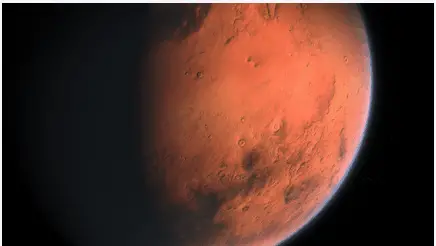
Activity of text interpretation, aimed at students in the seventh year of elementary school, about the planet Mars. This planet has two moons, with frightening names: Phobos (which means fear) and Deimos (which means panic), inherited from the horses that pulled the chariot of the god Mars. Let's get to know Mars better? So, read the text carefully! Then answer the various interpretative questions proposed!
You can download this text comprehension activity in an editable Word template, ready to print to PDF, as well as the completed activity.
Download this text interpretation exercise from:
SCHOOL: DATE:
PROF: CLASS:
NAME:
Read:
Mars is named after the Roman god of war, perhaps because of its reddish color reminiscent of blood. This planet has two moons, with frightening names: Phobos (which means fear) and Deimos (which means panic), inherited from the horses that pulled the chariot of the god Mars.
Like Earth, Mars has a layer of ice at its poles, mainly composed of “dry ice” – gas frozen carbon dioxide, like the one used to preserve popsicles sold in Styrofoam -, in addition to a little "ice of water". The planet also has extinct volcanoes, valleys, mountains, plateaus and has seasons of the year, although the Martians are twice as long as the terrestrial ones. Located on Mars, Mount Olympus is the largest known volcano in the Solar System: it is three times higher than Everest, the highest mountain on Earth, which is eight thousand meters high.
Mars is a rocky, dry planet that sometimes faces sandstorms, which form giant dunes. To set foot on this planet, it will be necessary to create spaceships that are faster than the current ones. Today, getting to Mars would take at least six months. Staying so long in space could cause serious damage to the astronauts' bodies.
Several probes have recently landed on the Martian surface and there is strong evidence that there was once liquid water on Mars. But the possibility that there was some kind of primitive life on the planet is still being investigated.
“Ciência Hoje das Crianças” magazine. Edition 165. Jan./Feb. 2006. Available in: .

Question 1 - Reread the beginning of the text:
“Mars is named after the Roman god of war, maybe due to its reddish color that resembles blood.”
The highlighted fragment displays:
( ) a certainty.
( ) a hypothesis.
( ) a recommendation.
Question 2 - In the segment “Like the Earth, Mars has an ice cap at its poles […]”, the term “How” was used to:
( ) introduce an example.
( ) express a conclusion.
( ) establish a comparison.
Question 3 - Taking into account the information present in the text, fill in the space indicated in the following sentence:
"The Martian _________________________ are twice as long as the terrestrial ones."
Question 4 - In the passage “[…] it is three times higher than Everest […]”, the author refers:
( ) to the planet Mars.
( ) to Mount Olympus.
( ) to the Solar System.
Question 5 - The passage “Mars is a rocky, dry planet […]” is:
( ) a narration.
( ) a description.
( ) an argument.
Question 6 – In the part "Several rigs landed recently on the Martian surface […]”, the underlined adverb expresses a circumstance of:
( ) place.
( ) mode.
( ) time.
Question 7 – According to the text, "there are strong indications that there was once liquid water on Mars." What does “evidence” mean?
( ) "signals".
( ) “alerts”.
( ) “contradictions”.
Question 8 – The text about the planet Mars has purposes:
( ) didactic.
( ) scientific.
( ) journalistic.
Per Denyse Lage Fonseca
Graduated in Languages and specialist in distance education.
 report this ad
report this ad

